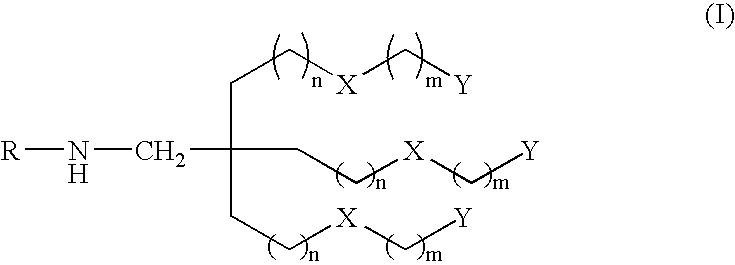Radiographic contrasting agents and radio-opaque polymeric materials for medical devices
- Summary
- Abstract
- Description
- Claims
- Application Information
AI Technical Summary
Problems solved by technology
Method used
Image
Examples
Embodiment Construction
[0013] The present invention provides a radiographic contrasting agent comprising a monosaccharide backbone or an aliphatic or alicyclic backbone of 2 to 12 carbon atoms, a reactive nucleophilic group, and at least two halogen-substituted aromatic groups. By “monosaccharide”, it is meant a simple sugar that cannot be hydrolyzed to smaller units. Empirical formula for monosaccharide is (CH2O)n, wherein n is an integer of 1 to 9. As used herein, “an aliphatic backbone” denotes an organic moiety consisting of carbon atoms linked in open chains, and “an alicyclic backbone” denotes an organic moiety consisting of carbon atoms forming one or more rings that are not aromatic. The aliphatic or alicyclic backbone of the present invention contains 2 to 12 carbon atoms. By “a reactive nucleophilic group”, it is meant a reactive chemical moiety having an affinity to atomic nuclei. Reactive nucleophilic groups suitable for the present invention include, but are not limited to: NRH, OH, and SH; w...
PUM
| Property | Measurement | Unit |
|---|---|---|
| Biodegradability | aaaaa | aaaaa |
| Opacity | aaaaa | aaaaa |
Abstract
Description
Claims
Application Information
 Login to View More
Login to View More - R&D
- Intellectual Property
- Life Sciences
- Materials
- Tech Scout
- Unparalleled Data Quality
- Higher Quality Content
- 60% Fewer Hallucinations
Browse by: Latest US Patents, China's latest patents, Technical Efficacy Thesaurus, Application Domain, Technology Topic, Popular Technical Reports.
© 2025 PatSnap. All rights reserved.Legal|Privacy policy|Modern Slavery Act Transparency Statement|Sitemap|About US| Contact US: help@patsnap.com



